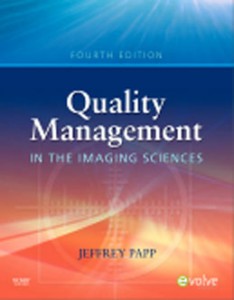Test Bank for Quality Management in the Imaging Sciences, 4th Edition: Papp
$35.00 Original price was: $35.00.$26.50Current price is: $26.50.
Test Bank for Quality Management in the Imaging Sciences, 4th Edition: Papp
This is completed downloadable of Test Bank for Quality Management in the Imaging Sciences, 4th Edition: Papp

Product Details:
- ISBN-10 : 0323057616
- ISBN-13 : 978-0323057615
- Author: Jeffrey Papp
With this single resource, you can access quality management and quality control information for all major imaging modalities! Updated with the latest changes in technology and federal regulations, Quality Management in the Imaging Sciences provides a thorough description of Quality Management and explains why it is so important to imaging technology. Step-by-step QM procedures include full-size evaluation forms, with instructions on how to evaluate equipment and document results. This book also helps you prepare effectively for the ARRT advanced certification exam in quality management.
Table of Content:
- CHAPTER 1 Introduction to Quality Management
- OBJECTIVES
- KEY TERMS
- HISTORY OF QUALITY MANAGEMENT IN RADIOLOGY
- Governmental Action
- TABLE 1-1 Mandatory Reporting Requirements for User Facilities
- The Joint Commission
- Quality Assurance
- Quality Control
- Continuous Quality Improvement
- BOX 1-1 Fourteen Points of Management
- PROCESS IMPROVEMENT THROUGH CONTINUOUS QUALITY IMPROVEMENT
- Key Quality Characteristics
- Key Process Variables
- Problem Identification and Analysis
- Group Dynamics
- Brainstorming
- Focus Groups
- Quality Improvement Team
- Quality Circles
- Multi-voting
- Consensus
- Work Teams
- Problem-Solving Teams
- Specific Quality Management Quality Improvement Processes
- TJC 10-Step Process
- TJC Cycle for Improving Performance
- Figure 1-1 Model for a storyboard.
- Figure 1-2 Cycle for improving performance, showing the important steps, including inputs and outputs, of a systematic approach to improvement.
- Other Quality Management/Quality Improvement Models
- Figure 1-3 Phases of FADE problem solving.
- Figure 1-4 The FOCUS-PDCA Model.
- SUMMARY
- REVIEW QUESTIONS
- CHAPTER 2 Quality Management Tools and Procedures
- OBJECTIVES
- KEY TERMS
- INFORMATION ANALYSIS
- Terminology Used in Statistical Analysis
- Population
- Sample
- Data Set
- Frequency
- Dependent Variables
- Independent Variables
- Continuous Variables
- Dichotomous Variables
- Central Tendency
- Reliability
- Accuracy
- Bias
- Error
- Range
- Standard Deviation
- Variance
- Poisson Distribution
- Gaussian Distribution
- FIGURE 2-1 Gaussian probability (normal) distribution.
- Variation
- Validity
- Information Analysis Tools
- Flowchart
- BOX 2-1 The Flowchart
- Cause-and-Effect Diagram
- Histogram
- Pareto Chart
- Scatter Plot
- FIGURE 2-2 Flowchart diagrams the process of eliminating scratches on images caused by film processors.
- FIGURE 2-3 A fishbone chart shows the effect of various parameters on key quality characteristics or outcomes of proper image quality.
- Trend Chart
- FIGURE 2-4 Histogram. Frequency of occurrence is demonstrated on the y-axis, and category or class interval is demonstrated on the x-axis. This example plots percentage of patients undergoing diagnostic procedures versus ages of patients.
- FIGURE 2-5 A Pareto chart indicates specific areas that cause unsatisfactory outcomes, so that improvement actions can be appropriately directed. IVP, Intravenous pyelography.
- FIGURE 2-6 A scatter plot graph shows relationship between a key outcome or characteristic (y-axis) and a key process variable (x-axis). Graph A indicates a positive correlation between two values, and graph B indicates that no correlation exists. mA, Milliampere; mR, milliroentgen.
- FIGURE 2-7 A trend graph displays amount of variation of indicator (radiation emitted from an x-ray generator) as a function of time. mAs, Milliampere-second; mR, milliroentgen.
- FIGURE 2-8 A control graph displays amount of variation of indicator (speed or medium density value from a sensitometry film) as a function of time, with upper and lower control limits indicated.
- Control Chart
- MISCELLANEOUS ADMINISTRATIVE RESPONSIBILITIES
- BOX 2-2 Administrative Procedures
- BOX 2-3 Quality Management Technologist Duties
- Threshold of Acceptability
- Communication Network
- Patient Comfort
- Personnel Performance
- Record-Keeping System
- Corrective Action
- RISK MANAGEMENT
- Risk Analysis
- Policies and Procedures
- RADIATION SAFETY PROGRAM
- Patient Radiation Protection
- Radiographic Examinations
- Fluoroscopic Examinations
- Visitor Protection
- Personnel Protection
- Time
- Distance
- Shielding
- SUMMARY
- REVIEW QUESTIONS
- CHAPTER 3 Film/Screen Image Receptors, Darkrooms, and Viewing Conditions
- OBJECTIVES
- KEY TERMS
- DARKROOM FUNCTION
- DARKROOM ENVIRONMENT
- Darkroom Characteristics
- FIGURE 3-1 Psychrometer for measuring relative humidity.
- Darkroom Lighting
- FIGURE 3-2 Standard darkroom film bin.
- Overhead Lighting
- Safelight
- Blue-Violet-Sensitive Film
- FIGURE 3-3 Visible light spectrum.
- FIGURE 3-4 Fixture type of darkroom safelight.
- FIGURE 3-5 Sodium vapor lamp darkroom safelight.
- Orthochromatic Film
- New Modality Film
- Other Film Types
- Light and Leakage Testing
- Safelight Testing
- FIGURE 3-6 Image of penetrometer showing safelight fog.
- PROCEDURE
- PROCEDURE
- Leakage Testing and Processing Area Condition
- PROCEDURE
- Film and Chemical Storage
- VIEWBOX QUALITY CONTROL
- Viewbox Illuminators
- Viewbox Quality Control Test
- FIGURE 3-7 Photographic light meter (photometer) for viewbox evaluation.
- BOX 3-1 Photometry
- Illuminance
- Luminance
- IMAGE DUPLICATING UNITS
- FIGURE 3-8 Duplicating unit for copying diagnostic images.
- PROCEDURE
- FILM/SCREEN IMAGE RECEPTORS
- Intensifying Screen Speed
- Intensification Factor
- Relative Speed Value
- Name of Screen
- TABLE 3-1 Older Names for Screen Speed
- Factors Affecting Screen Speed
- Type of Phosphor Material
- Thickness of Phosphor Layer
- Size of Phosphor Crystals
- Reflective Layer
- FIGURE 3-9 Effect of screen active layer on light diffusion and image sharpness.
- TABLE 3-2 Emission Color of Common Rare Earth Phosphors
- Light-Absorbing Dyes
- Ambient Temperature
- Kilovolt (Peak) Selection
- FIGURE 3-10 Reflected light within phosphor layer.
- TABLE 3-3 K-Shell Binding Energies for Some Phosphor Materials
- PROCEDURE
- Quality Control Testing of Screen Speed
- PROCEDURE
- Spectral Matching
- Screen Resolution
- Contrast Resolution
- FIGURE 3-11 Broadband spectrum from non-rare earth phosphor.
- FIGURE 3-12 Line spectrum from rare earth screen phosphor.
- Spatial Resolution
- FIGURE 3-13 Line pairs per millimeter resolution chart.
- TABLE 3-4 Comparison of Spatial Resolution and Line Size
- Point Spread Function
- FIGURE 3-14 Point spread function (PSF) graph.
- FIGURE 3-15 Line spread function (LSF) graph.
- Line Spread Function
- Edge Spread Function
- Modulation Transfer Function
- FIGURE 3-16 Edge spread function (ESF) graph.
- FIGURE 3-17 Weiner spectrum indicating the modulation transfer function (MTF).
- FIGURE 3-18 Effect of film/screen contact on light diffusion.
- FIGURE 3-19 Wire mesh image.
- PROCEDURE
- Screen Condition
- FIGURE 3-20 Ultraviolet (UV) lamp for inspecting intensifying screens.
- PROCEDURE
- SUMMARY
- REVIEW QUESTIONS
- CHAPTER 4 Film Processing
- OBJECTIVES
- KEY TERMS
- MANUAL AND AUTOMATIC FILM PROCESSING
- Manual Processing
- Procedure
- Automatic Processing
- PROCESSING CHEMICALS
- Developer
- Developer Components
- Developing or Reducing Agents
- Phenidone (Elon or Metol in Manual Developer)
- Hydroquinone
- Preservative
- Accelerator, Activator, or Buffering Agent
- FIGURE 4-1 Graph demonstrating superadditivity effect of phenidone and hydroquinone.
- FIGURE 4-2 Potential hydrogen (pH) scale.
- Restrainer, Regulator, Antifoggant, or Starter
- Hardener
- Solvent
- Sequestering Agent
- Developer Activity
- Solution Temperature (Fig. 4-3)
- FIGURE 4-3 Radiographs showing effect of solution temperature on optical density and contrast.
- Immersion Time (Fig. 4-4)
- Solution Concentration
- FIGURE 4-4 Radiographs showing effect of developer time on optical density and contrast.
- Type of Chemicals Used
- Solution pH
- Developer Mixing Procedure
- Premix or Ready-Mix
- Concentrate
- Fixer
- Fixer Ingredients
- Fixing Agent, Clearing Agent, or Hypo
- PROCEDURE
- Preservative
- Hardener or Tanning Agent
- Acidifier, Activator, or Buffer
- Sequestering Agent
- Solvent
- Fixer Mixing Procedure
- Washing
- FIGURE 4-5 Hyporetention kit for evaluating residual fixer in processed films.
- Chemical Safety
- AUTOMATIC PROCESSOR MAIN SYSTEMS
- Transport System
- Roller Subsystem
- FIGURE 4-6 Entrance rollers for automatic film processor.
- FIGURE 4-7 Transport rollers for automatic film processor.
- Transport Rack Subsystem
- FIGURE 4-8 Vertical rack assembly.
- FIGURE 4-9 Turnaround rack assembly.
- Drive Subsystem
- FIGURE 4-10 Drive system.
- FIGURE 4-11 Worm and drive gears.
- Temperature Control System
- Water-Controlled System
- Thermostatically Controlled System
- FIGURE 4-12 Mixing valve for warm-water automatic processors.
- FIGURE 4-13 Heat exchanger located in bottom of water tank in thermostatically controlled temperature system.
- Circulation System
- FIGURE 4-14 Developer circulation system filter.
- Replenishment System
- Volume Replenishment
- Flood Replenishment
- Dryer System
- FIGURE 4-15 Dryer air tubes.
- Electrical System
- TYPES OF AUTOMATIC PROCESSORS
- Processor Size
- Floor-Size Processor
- Intermediate-Size Processor
- Tabletop-Size Processor
- Processor Location
- Totally Inside
- Bulk Inside
- Bulk Outside
- Daylight Processing Systems and Processors
- SUMMARY
- REVIEW QUESTIONS
- CHAPTER 5 Processor Quality Control
- OBJECTIVES
- KEY TERMS
- CHEMICAL ACTIVITY
- Solution Temperature
- Processing Time
- FIGURE 5-1 Digital thermometer for monitoring solution temperatures.
- Replenishment Rate
- FIGURE 5-2 Time-in-solution (TIS) test tool.
- Solution pH
- Specific Gravity and Proper Mixing
- PROCESSOR CLEANING PROCEDURES
- FIGURE 5-3 Floating hydrometer for measurement of specific gravity (indicating value of 0.87 g/cm3).
- Daily
- PROCEDURE
- Monthly
- PROCEDURE
- Quarterly
- PROCEDURE
- Yearly
- PROCESSOR MAINTENANCE
- Scheduled Maintenance
- Preventative Maintenance
- Nonscheduled Maintenance
- Daily at Start-Up
- PROCEDURE
- Daily During Operation
- PROCEDURE
- Daily at Shutdown
- PROCEDURE
- Weekly
- PROCEDURE
- Monthly
- PROCEDURE
- Quarterly
- PROCEDURE
- Yearly
- PROCEDURE
- PROCESSOR MONITORING
- Sensitometer
- FIGURE 5-4 Sensitometer.
- FIGURE 5-5 Twenty-one–step sensitometry film image.
- Densitometer
- FIGURE 5-6 Densitometer for measurement of optical density.
- FIGURE 5-7 Diagram of incident and transmitted light. Io, Original intensity; It, transmitted intensity.
- Control Chart
- PROCEDURE
- Quality Control Film
- CHARACTERISTIC CURVE
- PROCESSOR TROUBLESHOOTING
- DAYLIGHT SYSTEMS
- FIGURE 5-8 Processor control chart.
- FIGURE 5-9 Crossover worksheet for determining new operating levels.
- FIGURE 5-10 Sample plotting of a characteristic curve.
- FIGURE 5-11 Daylight systems. LED, Light-emitting diode.
- PROCEDURE
- PROCEDURE
- TABLE 5-1 Processor Control Chart Troubleshooting Guide
- SUMMARY
- REVIEW QUESTIONS
- CHAPTER 6 Silver Recovery
- OBJECTIVES
- KEY TERMS
- JUSTIFICATION FOR SILVER RECOVERY
- Worldwide Supply of Silver
- Monetary Return to Department
- Federal and State Pollution Laws
- BOX 6-1 Important Federal Pollution Laws
- Water Pollution Control Act of 1972
- Resources Conservation/Hazardous Waste Act of 1976
- Clean Water Act of 1984
- Resource Conservation and Recovery Act of 1987
- SILVER RECOVERY FROM PROCESSING CHEMICALS
- Metallic Replacement
- Figure 6-1 Metallic replacement silver recovery unit.
- Figure 6-2 Diagram of metallic replacement cartridge.
- Steel Wool Cartridge
- Channeling
- Rusting
- Drain Stoppage
- BOX 6-2 Advantages of the Metallic Replacement Method
- BOX 6-3 Disadvantages of the Metallic Replacement Method
- Iron-Impregnated Foam Cartridge
- Electrolytic Silver Recovery
- Figure 6-3 “Piggybacking” or “tailing” of metallic replacement units.
- Figure 6-4 Diagram of electrolytic silver recovery unit.
- Figure 6-5 Cathodes from electrolytic silver recovery unit. Top cathode is clean and unused. Left cathode contains more than 20 lb of silver flake after correct amperage has been used. Right cathode contains silver that has been “burned” by too high of an amperage setting.
- Figure 6-6 Silver flake that has been removed from a cathode after correct amperage has been used.
- Terminal Electrolytic System
- Recirculating Electrolytic System
- BOX 6-4 Advantages of Electrolytic Silver Recovery
- BOX 6-5 Disadvantages of Electrolytic Silver Recovery
- Direct Sale of Used Fixer
- Chemical Precipitation
- Ion Exchange or Resin Systems
- BOX 6-6 Factors Affecting the Efficiency of Silver Recovery from Processing Solutions
- SILVER RECOVERY FROM FILM
- Green Film
- Scrap Exposed Film
- Archival Film
- SUMMARY
- REVIEW QUESTIONS
- CHAPTER 7 Quality Control of X-Ray Generators and Ancillary Radiographic Equipment
- OBJECTIVES
- KEY TERMS
- X-RAY GENERATORS
- Single-Phase Generator
- Half-Wave Rectified
- FIGURE 7-1 Voltage waveform graph of single-phase alternating current.
- FIGURE 7-2 Voltage waveform graph of half-wave rectified, single-phase current.
- Full-Wave Rectified
- Three-Phase Generator
- FIGURE 7-3 Voltage waveform graph of full-wave rectified, single-phase current.
- FIGURE 7-4 Voltage waveform graph of 3-phase alternating current.
- Three-Phase, Six-Pulse
- Three-Phase, 12-Pulse
- FIGURE 7-5 Voltage waveform graph of 3-phase, 6-pulse current.
- FIGURE 7-6 Voltage waveform graph of 3-phase, 12-pulse current.
- High-Frequency Generator
- Voltage Ripple
- FIGURE 7-7 Voltage waveform graph showing resultant current through the x-ray tube in a high frequency x-ray generator.
- Power Ratings
- CONTROL OR OPERATING CONSOLE
- HIGH-VOLTAGE GENERATOR
- X-RAY TUBE, TUBE ACCESSORIES, AND X-RAY TABLE
- QUALITY CONTROL PROGRAM FOR RADIOGRAPHIC UNITS
- Visual Inspection
- Control Panel
- Overhead Tube Crane
- Radiographic Table
- Protective Lead Apparel
- FIGURE 7-8 Image of lead apron demonstrating a large hole in the center.
- Miscellaneous Equipment
- Environmental Inspection
- Performance Testing
- Radiation Measurement
- FIGURE 7-9 The Noninvasive Evaluation of Radiation Output (NERO) is a microprocessor that can be programmed to acquire and analyze exposure data, providing quality control test results for numerous parameters.
- FIGURE 7-10 Schematic diagram of an ion chamber.
- Ion Chamber
- Proportional Counter
- Geiger-Müller Counter
- FIGURE 7-11 Graph showing how the intensity of the signal from a gas-filled detector increases as the voltage across the chamber increases. A, Region of recombination. B, Ionization region. C, Proportional region. D, Geiger-Müller region. E, Region of continuous discharge.
- FIGURE 7-12 Digital dosimeter.
- Reproducibility of Exposure
- PROCEDURE
- Radiation Output
- PROCEDURE
- Filtration Check
- PROCEDURE
- Kilovolt (Peak) Accuracy
- FIGURE 7-13 Semilog plot of radiation intensity versus attenuator thickness for determination of half-value layer (HVL).
- FIGURE 7-14 Wisconsin Test Cassette.
- FIGURE 7-15 Digital kilovolt (peak) meter.
- TABLE 7-1 Minimum HVL Values for Diagnostic X-Ray Units
- PROCEDURE
- Timer Accuracy
- FIGURE 7-16 Digital timer for radiographic units.
- FIGURE 7-17 Manual spinning top.
- FIGURE 7-18 Image from manual spinning top on a single-phase x-ray generator.
- FIGURE 7-19 Synchronous spinning top.
- FIGURE 7-20 A, Radiograph produced at 200 mA and 1/20-second exposure. B, RMI protractor template. C, Radiograph A with template showing acceptable results for a 1/20-second exposure. D, Radiograph produced at 200 mA and 1/30 second showing unacceptable results. mAs, Milliampere-second.
- Voltage Waveform
- Milliampere and Exposure Time Linearity and Reciprocity
- FIGURE 7-21 Voltage waveforms indicating various conditions within the x-ray generator.
- FIGURE 7-22 Output detector for obtaining voltage waveforms.
- PROCEDURE
- PROCEDURE
- Focal Spot Size
- FIGURE 7-23 Line focus principle.
- Pinhole Camera
- FIGURE 7-24 Concept of the pinhole camera.
- PROCEDURE
- Focal Spot Test Tool
- Resolution Chart
- FIGURE 7-25 Image from the focal spot test tool.
- FIGURE 7-26 Star resolution patterns.
- TABLE 7-2 Guide to Accompany Focal Spot Test Tool*
- TABLE 7-3 NEMA Values for Nominal Focal Spot Size Variation
- Beam Restriction System
- Light Field–Radiation Field Congruence
- FIGURE 7-27 Schematic of variable aperture collimator.
- FIGURE 7-28 Image obtained with a collimator test tool showing collimator is within accepted limits.
- FIGURE 7-29 Image obtained with the eight-penny test.
- PROCEDURE
- Collimator Test Tool
- PROCEDURE
- Eight-Penny (Nine-Penny) Test
- Image Receptor–Radiation Field Alignment
- Accuracy of the X-Y Scales
- PROCEDURE
- Illuminator Bulb Brightness
- PROCEDURE
- Beam Alignment
- Perpendicular
- FIGURE 7-30 Beam alignment tool.
- PROCEDURE
- Beam Alignment Tool
- X-Ray Beam-Bucky Tray Alignment or Central Ray Congruency
- Source-to-Image Distance and Tube Angulation Indicators
- FIGURE 7-31 A, Acceptable beam perpendicularity and beam-light field alignment. B, Unacceptable beam perpendicularity and beam-light alignment. Radiation beam (arrows) does not agree with collimator light field (broken arrows). Perpendicularity is out of alignment. Note top head is shifted to the right (arrowhead).
- PROCEDURE
- Beam Alignment Test Tool
- PROCEDURE
- Washer or Coin Method
- Overload Protection
- X-Ray Tube Heat Sensors
- FIGURE 7-32 Similar triangle configuration for determination of SID.
- PROCEDURE
- ANCILLARY EQUIPMENT
- AUTOMATIC EXPOSURE CONTROL SYSTEMS
- Detectors
- FIGURE 7-33 Sensor cell location for automatic exposure control (AEC) systems. A, Single-cell option. B, Three-sensor option.
- FIGURE 7-34 Schematic for photomultiplier tube and scintillation crystal.
- Photodetectors
- Ion Chambers
- Solid-State Detectors
- Comparator
- Automatic Exposure Control Testing
- FIGURE 7-35 Automatic exposure control (AEC) density selector settings.
- Backup, or Maximum Exposure, Time
- PROCEDURE
- Minimum Exposure Time
- Quality Control for Automatic Exposure Control
- Consistency of Exposure with Varying Milliampere
- PROCEDURE
- Consistency of Exposure with Varying Kilovolt (Peak)
- FIGURE 7-36 Automatic exposure control (AEC) test tool consisting of acrylic sheets of varying thickness.
- PROCEDURE
- Consistency of Exposure with Varying Part Thickness
- PROCEDURE
- Consistency of Exposure with Varying Field Sizes
- PROCEDURE
- Consistency of Automatic Exposure Control Detectors
- PROCEDURE
- Reproducibility
- PROCEDURE
- Density Control Function
- PROCEDURE
- Reciprocity Law Failure
- CONVENTIONAL TOMOGRAPHIC SYSTEMS
- FIGURE 7-37 Principle of linear tomography.
- FIGURE 7-38 Effect of tomographic angle on section thickness.
- FIGURE 7-39 Pluridirectional tomographic patterns.
- Quality Control of Tomographic Systems
- FIGURE 7-40 Tomographic test tool.
- Section Level
- FIGURE 7-41 Image from tomographic test tool indicating the level of tomographic section.
- Section Thickness
- TABLE 7-4 Section Thickness at Various Tomographic Angles
- FIGURE 7-42 Multipurpose tomographic test tool with section thickness ruler.
- Level Incrementation
- Exposure Angle
- Spatial Resolution
- FIGURE 7-43 Image from tomographic test tool indicating the resolution pattern.
- Section Uniformity and Beam Path
- FIGURE 7-44 Lead aperture of tomographic test tool.
- FIGURE 7-45 Image of lead aperture with linear tomography.
- FIGURE 7-46 Image of lead aperture with elliptical motion.
- PROCEDURE
- Patient Exposure
- Grids
- Grid Uniformity
- PROCEDURE
- Grid Alignment
- FIGURE 7-47 Grid alignment tool.
- PORTABLE AND MOBILE X-RAY GENERATORS
- Portable X-Ray Generator
- Mobile X-Ray Generator
- Direct-Power Units
- TABLE 7-5 Comparison of Mobile Radiographic Units
- Capacitor Discharge Units
- Cordless, or Battery-Powered, Mobile Units
- High-Frequency Mobile Units
- SUMMARY
- REVIEW QUESTIONS
- CHAPTER 8 Quality Control of Fluoroscopic Equipment
- OBJECTIVES
- KEY TERMS
- INTRODUCTION TO FLUOROSCOPIC EQUIPMENT
- Image Intensifiers
- Components
- Glass Envelope
- FIGURE 8-1 Schematic of image intensifier tube. CsI, Cesium iodide; Cs-Sb, cesium antimony.
- FIGURE 8-2 Cesium iodide light pipe.
- Input Phosphor
- Photocathode
- Electrostatic Focusing Lenses
- Anode
- Output Phosphor
- Image Brightness
- BOX 8-1 Factors Affecting the Brightness of Fluoroscopic Images
- Milliampere
- Kilovolt (Peak)
- Patient Thickness and Tissue Density
- Automatic Brightness Control or Automatic Brightness Stabilization
- Multifield Image Intensifiers
- Dual Focus
- Trifocus
- Image Intensifier Artifacts
- FIGURE 8-3 Multifield image intensifier showing normal and magnification modes.
- Veiling Glare, or Flare
- Pincushion Distortion
- Barrel Distortion
- Vignetting
- FIGURE 8-4 S, pincushion, and barrel distortion.
- S Distortion
- Image Monitoring Systems
- Mirror Optics
- Closed-Circuit Television Monitoring
- Television Camera
- Orthicon
- Plumbicon
- Vidicon
- Charge-Coupled Device
- FIGURE 8-5 Orthicon television camera tube.
- FIGURE 8-6 Representation of photodetector/pixel arrangement in charge-coupled device (CCD).
- Linkage from the Television Camera to Output Phosphor
- Fiber Optics
- Lens Coupling
- Television Monitor
- FIGURE 8-7 Principle of fiber optics.
- FIGURE 8-8 Split mirror for monitoring fluoroscopic images.
- Cinefluorography
- Photofluorospot, or Spot Film, Camera
- Film/Screen Spot Film Devices
- Digital Image Recorders
- QUALITY CONTROL OF FLUOROSCOPIC EQUIPMENT
- Visual Inspection
- FIGURE 8-9 Film/screen spot film formats.
- FIGURE 8-10 Fluoroscopic beam alignment device.
- Environmental Inspection
- Performance Testing
- Reproducibility of Exposure
- PROCEDURE
- Focal Spot Size
- PROCEDURE
- Filtration Check
- PROCEDURE
- TABLE 8-1 Half-Value Layer Valves for Common Fluoroscopic Kilovolts (Peak)
- Kilovolt (Peak) Accuracy
- PROCEDURE
- Milliampere Linearity
- PROCEDURE
- X-Ray Tube Heat Sensors
- PROCEDURE
- Grid Uniformity and Alignment
- PROCEDURE
- Voltage Waveform
- Automatic Brightness Stabilization Systems
- PROCEDURE
- Automatic Gain Control
- PROCEDURE
- Maximum Entrance Exposure Rate
- PROCEDURE
- Standard Entrance Exposure Rates
- FIGURE 8-11 Diagram of fluoroscopic units with the image intensifier mounted above or below the tabletop.
- FIGURE 8-12 Fluoroscopic phantom of the Centers for Devices and Radiological Health (CDRH).
- PROCEDURE
- High-Contrast Resolution
- FIGURE 8-13 Image of fluoroscopic high-contrast resolution test tool.
- Low-Contrast Resolution
- PROCEDURE
- Source–Skin Distance
- FIGURE 8-14 Low-contrast resolution rest tool.
- PROCEDURE
- Distortion
- Image Lag
- PROCEDURE
- Image Noise
- PROCEDURE
- Relative Conversion Factor
- Veiling Glare, or Flare
- Fluoroscopic Systems for Cardiac Catheterization and Interventional Procedures
- FIGURE 8-15 Video waveforms.
- FIGURE 8-16 Rotatable spoke test pattern.
- Video Monitor Performance
- FIGURE 8-17 Test pattern of the Society of Motion Picture and Television Engineers (SMPTE).
- PROCEDURE
- SUMMARY
- REVIEW QUESTIONS
- CHAPTER 9 Digital and Advanced Imaging Equipment
- OBJECTIVES
- KEY TERMS
- DIGITAL RADIOGRAPHIC IMAGING SYSTEMS
- FIGURE 9-1 Images showing the difference in spatial resolution as the size of the matrix increases.
- Secondary Capture
- Laser Scanning Digitizer
- FIGURE 9-2 Laser scanning digitizer.
- Charge-Coupled Device Scanner
- Computed Radiography (CR)
- FIGURE 9-3 The computed radiography (CR) Image Reader Device (IRD).
- FIGURE 9-4 Schematic diagram of a computed radiography (CR) reader system. PMT, Photomultiplier tube.
- FIGURE 9-5 A histogram from a CR system.
- FIGURE 9-6 The computed radiography (CR) system workstation.
- FIGURE 9-7 Effect of contrast enhancement on a radiographic image.
- FIGURE 9-8 Effect of edge enhancement on a radiographic image.
- FIGURE 9-9 Look-up tables for digital image processing. The curve shape defines the relationship between the intensity of exposure and image brightness (comparable to optical density in film images). (A) High contrast curve. (B) Low-contrast (wide latitude) curve. (C) Linear response curve with a reversed grayscale.
- Advantages of Computed Radiography versus Conventional Radiography
- FIGURE 9-10 Effect of energy subtraction on a chest examination. The image on the left has bony structures subtracted while the image on the right shows soft tissue subtraction.
- TABLE 9-1 Percentage Dose Reduction for Various Radiographic Examinations
- FIGURE 9-11 Plot of system response of film/screen imaging system and digital radiographic imaging plate.
- Disadvantages of Computed Radiography versus Conventional Radiography
- TABLE 9-2 List of CR Manufacturers (Selling in the United States)
- Digital Radiography
- FIGURE 9-12 Flat-panel x-ray image receptor. ADC, Analog-to- digital converter.
- FIGURE 9-13 Illustration of a section of the active matrix array (AMA) showing the switch associated with each pixel.
- Indirect-conversion or Scintillator Digital Radiography System
- Direct-conversion or Photoconductor Digital Radiography System
- Comparison of Computed Radiography with Digital Radiography
- TABLE 9-3 List of DR Manufacturers (Selling in the United States)
- Quality Control of Digital Radiographic Imaging Systems
- FIGURE 9-14 Digital radiographic image with artifact caused by dirt on plate.
- FIGURE 9-15 Boston CR Test Tool.
- BOX 9-1 Digital Radiography Phantom Image Testing
- Digital Fluoroscopy
- Last Frame–Hold
- Road Mapping
- Digital Temporal Filtering
- BOX 9-2 Summary of QC Tests for CR and DR Systems
- Acceptance Tests—performed by medical physicist
- Daily Tests—performed by technologist
- Weekly Tests—performed by technologist
- Monthly Tests—performed by technologist
- Semiannual/Annual Tests—performed by medical physicist
- Image Enhancement
- Image Restoration
- Image Intensifier Tube Digital Fluoroscopy Systems
- FIGURE 9-16 Block diagram of digital fluoroscopic system.
- Flat-panel Digital Fluoroscopy Systems
- Continuous Fluoroscopy Mode
- Pulsed Interlaced Scan Mode
- Pulsed Progressive Scan Mode
- Slow Scan Mode
- Digital Subtraction Angiography
- FIGURE 9-17 Image obtained during digital subtraction angiography (DSA).
- Temporal Mask Subtraction
- Time-Interval Difference Subtraction
- FIGURE 9-18 Block diagram of DSA.
- FIGURE 9-19 Images demonstrating temporal subtraction. Figures A and B show subtraction, while C shows the original image.
- FIGURE 9-20 Images showing the effect of TID subtraction process.
- Dual-Energy Subtraction
- Quality Control of Digital Fluoroscopy Units
- FIGURE 9-21 Digital subtraction angiography (DSA) phantom. A, Slot block. B, Bone block. C, Step wedge. D, Block insert. E, High-contrast resolution pattern insert. F, Linearity insert. G, Low-contrast artery insert. H, Low-contrast iodine line pair insert.
- ELECTRONIC DISPLAY DEVICES
- Cathode-Ray Tube Displays
- FIGURE 9-22 Block diagram showing various classifications of electronic display devices.
- FIGURE 9-23 Basic components of a cathode-ray tube display device.
- Liquid Crystal Displays
- FIGURE 9-24 Basic components of a liquid crystal display device.
- Plasma Displays
- Quality Control of Electronic Display Devices
- FIGURE 9-25 AAPM TG-18 QC Test Pattern.
- PROCEDURE
- Monthly/Quarterly
- MULTIFORMAT CAMERAS
- Components
- FIGURE 9-26 AAPM TG18-LN01 Test Pattern.
- FIGURE 9-27 AAPM TG18-LN08 Test Pattern.
- FIGURE 9-28 AAPM TG18-LN18 Test Pattern.
- FIGURE 9-29 AAPM TG18-CT Test Pattern.
- Brightness
- Contrast
- FIGURE 9-30 AAPM TG18-MP Test Pattern.
- FIGURE 9-31 AAPM TG18-UNL10 Test Pattern.
- Exposure Time
- FIGURE 9-32 AAPM TG18-UNL80 Test Pattern.
- FIGURE 9-33 AAPM TG18-CX Test Pattern.
- Quality Control of Multiformat Cameras
- FIGURE 9-34 AAPM TG18-AD Test Pattern.
- FIGURE 9-35 AAPM TG18 PQC Test Pattern.
- LASER CAMERAS
- Components
- FIGURE 9-36 Format patterns for multiformat cameras.
- BOX 9-3 Summary of Viewing Monitor QC
- Monthly/Quarterly
- Annual
- PROCEDURE
- FIGURE 9-37 Schematic diagram of multiformat camera. CRT, Cathode-ray tube.
- FIGURE 9-38 Society of Motion Picture and Television Engineers (SMPTE) test pattern.
- FIGURE 9-39 Schematic diagram of a laser camera.
- Quality Control of Laser Cameras
- PROCEDURE
- DRY LASER PRINTERS
- FIGURE 9-40 Schematic diagram of a dry laser printer.
- FIGURE 9-41 Demonstration of step test pattern for evaluation of dry laser printer.
- CATHODE-RAY TUBE CAMERAS
- Components
- Quality Control of Cathode-Ray Tube Cameras
- VIDEOTAPE, VIDEODISC, AND DIGITAL RECORDERS
- Components
- Quality Control of Analog and Digital Recorders
- PROCEDURE
- CINEFLUOROGRAPHY AND PHOTOFLUOROGRAPHY
- FIGURE 9-42 Diagram of a cine camera.
- FIGURE 9-43 Cine-video quality control phantom.
- FIGURE 9-44 Diagram of a cine film processor.
- IMAGE ARCHIVING AND MANAGEMENT NETWORKS
- FIGURE 9-45 Picture archiving and communication system (PACS) test pattern.
- MISCELLANEOUS SPECIAL PROCEDURES EQUIPMENT
- PROCEDURE
- Film Changers
- Pressure Injectors
- BONE DENSITOMETRY SYSTEMS
- Single-Photon Absorptiometry
- Single-Energy X-Ray Absorptiometry
- Dual-Photon Absorptiometry
- Dual-Energy X-Ray Absorptiometry
- TABLE 9-4 World Health Organization Definitions of Bone Density Levels
- Quantitative Computed Tomography
- Quantitative Ultrasound
- Digital X-Ray Radiogrammetry
- Quality Control of Bone Densitometry Equipment
- FIGURE 9-46 Dual-energy x-ray absorptiometry (DEXA) phantom used for determining the accuracy of bone density measurements.
- SUMMARY
- REVIEW QUESTIONS
- CHAPTER 10 Outcomes Assessment of Radiographic Images
- OBJECTIVES
- KEY TERMS
- REPEAT ANALYSIS
- Advantages
- Improved Department Efficiency
- Lower Department Costs
- Lower Patient Doses
- Causal Repeat Rate
- TABLE 10-1 Nationwide Averages of Repeat Causes for Departments with Quality Control Procedures
- Total Repeat Rate
- ARTIFACT ANALYSIS
- Film/Screen Radiography
- Processing Artifacts
- Emulsion Pickoff
- Figure 10-1 Repeat analysis worksheet (Film/screen). C-Spine, Cervical spine; IVP, intravenous pylelography; LGI, lower gastrointestinal tract; L-Spine, lumbar spine; T-Spine, thoracic spine; UGI, upper gastrointestinal tract.
- Figure 10-2 Repeat analysis worksheet (CR/DR).
- Gelatin Buildup
- Curtain Effect
- Chemical Fog
- Guide Shoe Marks
- Figure 10-3 Curtain effect.
- Pi Lines
- Figure 10-4 Chemical fog.
- Figure 10-5 Guide shoe marks.
- Figure 10-6 Pi lines.
- Chatter
- Dichroic Stain
- Reticulation Marks
- Streaking
- Hesitation Marks
- Figure 10-7 Streaking.
- Water Spots
- Wet-Pressure Sensitization
- Figure 10-8 Hesitation marks.
- Figure 10-9 Water spots.
- Hyporetention
- Insufficient Optical Density
- Excessive Optical Density
- Figure 10-10 Wet-pressure sensitization.
- Exposure Artifacts
- Motion
- Patient Artifacts
- Improper Optical Density
- Improper Patient Position or Missing Anatomy of Interest
- Figure 10-11 Hyporetention.
- Quantum Mottle
- Poor Film-to-Screen Contact
- Double Exposure
- Grid Artifacts
- Grid Lines
- Figure 10-12 Grid lines.
- Figure 10-13 Grid cutoff.
- Figure 10-14 Moiré effect, or zebra pattern, artifact.
- Grid Cutoff
- Moiré Effect
- Handling and Storage Artifacts
- Light Fog
- Age Fog
- Safelight Fog
- Radiation Fog
- Pressure Marks
- Static
- Tree Static
- Crown Static
- Smudge Static
- Crescent or Crinkle Marks
- Scratches
- Cassette Marks
- Computed Radiography and Digital Radiography Artifacts
- Figure 10-15 Image demonstrating static artifacts.
- Figure 10-16 Crescent marks.
- Heat Blur
- Improper Image Brightness
- Figure 10-17 Cassette marks.
- Quantum Mottle
- Defects in the Imaging Plate
- Phantom Image Artifact
- Increased Sensitivity to Scatter
- Figure 10-18 Quantum mottle occurring in a CR image.
- Figure 10-19 Artifact caused by scratches on a CR image plate.
- Double Exposure
- Computed Radiography Scanner Malfunction
- Foreign Objects
- Halo Artifacts
- Printer Errors
- Figure 10-20 Phantom image caused by incomplete erasure of CR imaging plate.
- Figure 10-21 Double exposure.
- Figure 10-22 Scan lines appearing on digital image.
- DIAGNOSTIC PERFORMANCE MEASUREMENT
- Figure 10-23 Artifact caused by dirt on CR imaging plate.
- Figure 10-24 Shading occurring during hard copy printing.
- Figure 10-25 Corduroy effect.
- Figure 10-26 Graph showing patients with disease versus healthy patients.
- Accuracy
- Sensitivity
- Specificity
- Positive Predictive Value
- Negative Predictive Value
- Figure 10-27 Statistical phantoms for A, radiographic; B, mammographic; and C, fluoroscopic images.
- Receiver Operator Characteristic Curve
- Figure 10-28 ROC Curve. The 45 degree diagonal line in the graph indicates pure guesswork by the observer. The curve on the left hand side of the graph depicts an accurate imaging procedure.
- SUMMARY
- REVIEW QUESTIONS
- CHAPTER 11 Mammographic Quality Standards
- OBJECTIVES
- KEY TERMS
- DEDICATED MAMMOGRAPHIC EQUIPMENT
- X-Ray Generator
- FIGURE 11-1 Dedicated mammographic unit.
- X-Ray Tube
- X-Ray Tube Window
- Target Composition
- FIGURE 11-2 Emission spectrum for tungsten-rhenium target. keV, Kiloelectron volt.
- Milliampere
- Kilovolt (Peak)
- Added Filtration
- Target Material
- FIGURE 11-3 Effect of mA on emission spectrum. keV, Kiloelectron volt; mA, milliampere.
- FIGURE 11-4 Effect of kVp on emission spectrum. keV, Kiloelectron; kVp, kilovolt (peak).
- FIGURE 11-5 Effect of added filtration on emission spectrum. Al, Aluminum; keV, kiloelectron volt.
- Tungsten (Atomic Number, 74)
- FIGURE 11-6 Effect of target material on emission spectrum. keV, Kiloelectron volt; z, atomic number.
- Molybdenum (Atomic Number, 42)
- Rhodium (Atomic Number, 45)
- Molybdenum-Rhodium-Tungsten Alloy
- Voltage Waveform/Ripple
- Focal Spot Size
- FIGURE 11-7 Effect of voltage waveform on emission spectrum. keV, Kiloelectron volt.
- Source-to-Image Distance and Target Angle
- Compression
- BOX 11-1 Advantages of Breast Compression
- Grids
- Image Receptors
- Film Processors
- Magnification Mammography
- FIGURE 11-8 Technique chart for mammographic imaging with AEC.
- Digital Mammography Systems
- Stereotactic Localization
- MAMMOGRAPHIC QUALITY ASSURANCE
- MQSA and Mammography Quality Standards Reauthorization Act
- Quality Control Responsibilities
- Radiologist (Interpreting Physician)
- Medical Physicist
- Film/Screen Systems
- Automatic Exposure Control
- Kilovolt (Peak) Accuracy and Reproducibility
- Focal Spot Condition
- Beam Quality and Half-Value Layer
- Breast Entrance Air Kerma and Automatic Exposure Control Reproducibility
- Dosimetry
- TABLE 11-1 Standards of the National Electrical Manufacturers Association
- TABLE 11-2 Values for Minimum Acceptable Half-Value Layer X-Ray Tube Voltage (kVp) and Minimum HVL
- FIGURE 11-9 Conventional mammographic phantom (A) and anthropomorphic (lifelike) phantom (B).
- X-Ray Field/Light Field/Image Receptor/Compression Paddle Alignment
- Uniformity of Screen Speed
- System Artifacts
- Radiation Output
- Decompression
- Quality Control Tests-Other Modalities
- Viewbox Illuminators and Viewing Conditions
- Comparison of Test Results with Action Limits
- Additional Evaluations
- Digital Mammography Systems
- Quality Control Tests—Other Modalities
- FIGURE 11-10 American College of Radiology (ACR) Medical Physicist MQSA Checklist.
- FIGURE 11-11 American College of Radiology (ACR) Physicist’s Mammography QC Test Summary for Film/Screen Systems.
- Radiologic Technologist (Mammographer)
- FIGURE 11-12 American College of Radiology (ACR) Physicist’s Mammography QC Test Summary for GE FFDM Systems.
- FIGURE 11-13 American College of Radiology (ACR) Physicist’s Mammography QC Test Summary for Fischer FFDM System.
- Film/Screen Systems
- Daily Duties
- Darkroom Cleanliness
- Processor Quality Control
- FIGURE 11-14 American College of Radiology (ACR) Physicist’s Mammography QC Test Summary for Lorad FFDM Systems.
- FIGURE 11-15 American College of Radiology (ACR) Physicist’s Mammography QC Test Summary for Siemens FFDM.
- Weekly Duties
- Screen Cleanliness
- FIGURE 11-16 American College of Radiology (ACR) Physicist’s Mammography QC Test Summary for Fuji FCRm.
- Phantom Images
- FIGURE 11-17 American College of Radiology (ACR) processor control chart.
- Monthly Duties
- Quarterly Duties
- Repeat Analysis
- FIGURE 11-18 American College of Radiology (ACR) accreditation phantom.
- PROCEDURE
- Archival Quality
- PROCEDURE
- Semiannual Duties
- Darkroom Fog
- FIGURE 11-19 American College of Radiology (ACR) phantom control chart.
- FIGURE 11-20 American College of Radiology (ACR) Mammographer QC checklist for daily/weekly duties.
- PROCEDURE
- FIGURE 11-21 American College of Radiology (ACR) visual checklist.
- FIGURE 11-22 American College of Radiology (ACR) Repeat-Reject Analysis Chart.
- Film/Screen Contact
- PROCEDURE
- FIGURE 11-23 Hyporetention estimator test strip.
- Compression
- Full-Field Digital Mammography Systems
- Daily Duties
- FIGURE 11-24 Wire mesh test images showing (A) good and (B) poor film screen contrast.
- FIGURE 11-25 Mammographic compression scale.
- Weekly Duties
- FIGURE 11-26 American College of Radiology (ACR) Mammographer QC checklist for monthly, quarterly, and semi-annual duties.
- Monthly Duties
- Quarterly Duties
- Semi-annual Duties
- FIGURE 11-27 American College of Radiology (ACR) Mammography QC checklist for daily and weekly tests for GE FFDM systems.
- FIGURE 11-28 American College of Radiology (ACR) Mammography QC checklist for daily and weekly tests for Lorad FFDM systems.
- Inspection by the Food and Drug Administration
- FIGURE 11-29 American College of Radiology (ACR) Mammography QC checklist for daily and weekly tests for Fischer FFDM systems.
- Equipment Performance
- Records
- FIGURE 11-30 American College of Radiology (ACR) Mammography QC checklist for daily and weekly tests for Siemens FFDM systems.
- FIGURE 11-31 American College of Radiology (ACR) Mammography QC checklist for daily and weekly tests for Fuji FCRm systems.
- FIGURE 11-32 American College of Radiology (ACR) Mammography QC checklist for monthly, quarterly, and semi-annual duties for GE FFDM systems.
- FIGURE 11-33 American College of Radiology (ACR) mammography QC checklist for monthly, quarterly, and semi-annual duties for Lorad FFDM systems.
- Inspection Report
- Level 1
- FIGURE 11-34 American College of Radiology (ACR) Mammography QC checklist for monthly, quarterly, and semi-annual duties for Fischer FFDM systems.
- FIGURE 11-35 American College of Radiology (ACR) Mammography QC checklist for monthly, quarterly, and semi-annual duties for Siemens FFDM systems.
- FIGURE 11-36 American College of Radiology (ACR) Mammography QC checklist for monthly, quarterly, and semi-annual duties for Fuji FCRm system.
- PROCEDURE
- TABLE 11-3 Summary of Responsibilities for Mammography
- BOX 11-2 Definitions by the Food and Drug Administration
- Level 2
- Level 3
- No Findings
- SUMMARY
- REVIEW QUESTIONS
- CHAPTER 12 Quality Control in Computed Tomography
- OBJECTIVES
- KEY TERMS
- ACCEPTANCE TESTING
- ROUTINE TESTING
- Figure 12-1 This computed tomography (CT) phantom is used to evaluate noise, spatial resolution, contrast resolution, slice thickness, linearity, and uniformity.
- Figure 12-2 Photograph (A) and computed tomography (CT) image (B) of the five-pin test phantom designed by the American Association of Physicists in Medicine. The attenuation coefficient for each pin is known precisely and the CT number computed.
- Alignment Light Accuracy
- PROCEDURE
- Figure 12-3 Sample quality assurance data form.
- Image Quality
- High-Contrast (Spatial) Resolution
- Figure 12-4 Technique for assessing laser light accuracy.
- PROCEDURE
- Test—High-Contrast Resolution
- American College of Radiology Acceptance Criteria
- Low-Contrast Resolution
- PROCEDURE
- Test—Low-Contrast Resolution
- Figure 12-5 CT image from module 2 of the ACR, CT accreditation Phantom demonstrating placement of ROIs for assessing low-contrast resolution.
- American College of Radiology Acceptance Criteria
- Image Uniformity
- PROCEDURE
- Figure 12-6 Test for noise and uniformity. ROI, Region of interest.
- Test—Image Uniformity
- American College of Radiology Acceptance Criteria
- Noise
- Test—Noise
- American College of Radiology Acceptance Criteria
- Computed Tomography Number Accuracy
- PROCEDURE
- Figure 12-7 Test for contrast scale. ROI, Region of interest.
- Test–Computed Tomography Number Accuracy
- American College of Radiology Acceptance Criteria
- Slice Thickness
- PROCEDURE
- Test—Slice Thickness
- American College of Radiology Acceptance Criteria
- Figure 12-8 Test objects used for determining slice thickness.
- Linearity
- PROCEDURE
- Patient Dose
- Figure 12-9 Phantom with known physical and x-ray absorption properties used for measuring linearity. HU, Hounsfield unit.
- Figure 12-10 Graph showing computed tomography (CT) linearity. L, Lexan; N, nylon; P, Plexiglas; PE, polyethylene; PS, polystyrene; W, water.
- Figure 12-11 Isodose curves for a typical computed tomography (CT) scanner.
- PROCEDURE
- TABLE 12-1 Computed Tomography Dose Index
- TABLE 12-2 ACR CT Accreditation Dose Pass/Fail Criteria and Reference Levels
- SUMMARY
- REVIEW QUESTIONS
- CHAPTER 13 Quality Control for Magnetic Resonance Imaging Equipment
- OBJECTIVES
- KEY TERMS
- PHANTOMS
- FIGURE 13-1 Left, Body coil phantom and holder. Right, Head coil phantom and holder.
- QC TESTING FREQUENCY
- WEEKLY TESTS
- Setup and Table Positioning Accuracy
- PROCEDURE
- Center (Resonance) Frequency
- PROCEDURE
- Transmit Gain (Attenuation)
- Geometric Accuracy (Three Axes)
- PROCEDURE
- FIGURE 13-2 Example of gradient amplitude falloff resulting in A-P minification of a T1-weighted (T1W) axial image of the upper abdomen.
- High-Contrast Resolution (Spatial Resolution)
- FIGURE 13-3 Sagittal localizer with end-to-end measurement shown (arrow).
- FIGURE 13-4 Slice 1 from ACR T1 series with diameter measurements shown (arrows).
- FIGURE 13-5 Slice 5 from ACR T1 series with diameter measurements shown (arrows).
- PROCEDURE
- FIGURE 13-6 Slice 1 from ACR T2 series demonstrating resolution insert and hole array pairs.
- FIGURE 13-7 Magnified portion of slice 1 displayed for visual assessment of high-contrast resolution.
- Low-Contrast Resolution (Detectability)
- PROCEDURE
- FIGURE 13-8 Slice 2 of ACR T1 series with the circle of low-contrast objects displayed.
- Artifact Analysis
- Film Quality Control
- PROCEDURE
- Visual Checklist
- ANNUAL TESTS
- Magnetic Field Homogeneity
- BOX 13-1 Quality Control Tests Performed by a Medical Physicist or System Engineer
- Slice Position Accuracy
- PROCEDURE
- FIGURE 13-9 Slice 1 of ACR T1 series with pair of dark vertical bars from the 45° crossed wedges indicated.
- FIGURE 13-10 Slice 2 of ACR T1 series with pair of dark vertical bars from the 45° crossed wedges indicated.
- FIGURE 13-11 Magnified portion of slice 1 showing measurement for slice position error. The arrows indicate the difference in bar length.
- Slice Thickness Accuracy
- PROCEDURE
- Radiofrequency Coils (Fig. 13-15)
- FIGURE 13-12 Slice 1 from ACR T2 series demonstrating the slice thickness insert and signal ramps.
- FIGURE 13-13 Magnified portion of slice 1 showing placement for rectangular ROIs to measure average signal in the ramps.
- FIGURE 13-14 Magnified portion of slice 1 showing measurements for the slice thickness signal ramps.
- FIGURE 13-15 Nonuniformity of image intensity produced by radiofrequency (RF) field inhomogeneity. Note the region of hypointensity in the left flank. The cause in this case is improper setting of active shim coil current; an unwanted focal gradient is produced in the main magnetic field.
- Signal-to-Noise Ratio
- PROCEDURE
- FIGURE 13-16 Radiofrequency (RF) interference from a steady carrier frequency source. A strong signal from the nitrogen fill–monitor circuit is detected within the pass-band of the magnetic resonance imaging (MRI) receiver. It is displayed as a full vertical column perpendicular to the x coordinate that corresponds to the frequency of the spurious signal. The overall receiver performance is degraded by intermodulation distortion, which causes the background noise level to rise in comparison with the signal of the phantom.
- Image Intensity Uniformity
- Percent Signal Ghosting (PSG)
- FIGURE 13-17 A, A signal-to-noise ratio (SNR) test performed with the body coil phantom. B, An SNR test performed with the head coil phantom. Note that the head coil yields a higher SNR.
- BOX 13-2 Image Uniformity Calculation
- Interslice Radiofrequency Interference
- Soft-copy Display Devices
- PROCEDURE
- OPTIONAL TESTS
- Signal-to-Noise Ratio Consistency
- Magnetic Fringe Field
- SUMMARY
- REVIEW QUESTIONS
- CHAPTER 14 Ultrasound Equipment Quality Assurance
- OBJECTIVES
- KEY TERMS
- COMPONENTS OF AN ULTRASOUND QUALITY ASSURANCE PROGRAM
- Quality Assurance and Preventive Maintenance
- Tissue-Mimicking Phantoms
- Tissue Properties Represented in Phantoms
- Typical Quality Assurance Phantom Design
- FIGURE 14-1 Example of a general-purpose quality assurance phantom. A, Phantom being imaged with an ultrasound scanner. B, Close-up of phantom, with diagram of interior contents. C, B-mode image of the phantom.
- BOX 14-1 Tissue Attenuation Coefficients
- Cautions About Phantom Desiccation
- FIGURE 14-2 A phantom with rubber-based, tissue-mimicking small parts. Although the acoustic properties are not as precise as the water-based phantoms, less care is required during manufacturing and with on-site storage to minimize changes over time.
- BASIC QUALITY CONTROL TESTS
- Visual Inspection
- Transducer Choice
- System Sensitivity
- FIGURE 14-3 Images obtained for the maximum depth of the visualization quality assurance test with a multifrequency array transducer. The phantom has an attenuation coefficient of 0.7 dB/cm per megahertz. A, At 4 MHz the maximum depth of visualization is 16.8 cm. B, At 2 MHz the maximum depth of visualization cannot be determined with this phantom because visualization remains excellent all the way to the bottom of the phantom.
- Photography and Gray-Scale Hard Copy
- Monitor Setup and Recording Devices
- FIGURE 14-4 A test pattern of the Society of Motion Picture and Television Engineers (SMPTE). The pattern contains a gray-scale range in increments of 10% video level. There are also 5% contrast patches at the 0% (black) and 100% (white) levels, a mesh pattern to check for spatial distortions, and several resolution patterns.
- Routine Quality Assurance of Image Recording
- Scan Image Uniformity
- FIGURE 14-5 Image uniformity tests. A, Good uniformity. B, Results with a transducer that should be repaired or replaced. Note the vertical streaks that are evidence of element dropout for this linear array transducer.
- Distance Measurement Accuracy
- Vertical Distance Measurements
- FIGURE 14-6 Vertical distance measurement check. The caliper reading (13.94 cm) is compared with the actual separation (14 cm) between pins positioned along a vertical column in the phantom. Shorter distances should be used when high-frequency transducers are evaluated.
- FIGURE 14-7 Horizontal distance measurement check. The caliper reading (90.7 mm) is for a measurement taken horizontally on the image and compared with the actual pin separation (90 mm).
- Horizontal Distance Measurements
- Other Important Instrument Quality Assurance Tasks
- DOCUMENTATION
- SPATIAL RESOLUTION TESTS
- Axial Resolution
- FIGURE 14-8 Axial resolution measurement. The thickness of the pin target is 0.65 mm. In the axial resolution target set (vertical separation 2 mm, 1 mm, 0.5 mm, and 0.25 mm), the 1-mm pair is separated a sufficient distance vertically so that there is no vertical overlap of the images of these two targets, whereas the 0.5-mm pair overlaps if the two targets are on a vertical line. The axial resolution is just over 0.5 mm, in agreement with the estimate made from the thickness of the single target image.
- BOX 14-2 Ultrasound Quality Control Results
- Lateral Resolution
- Cautions About Resolution Tests with Discrete Targets
- FIGURE 14-9 Lateral resolution measurement. The horizontal size of the pin target is 0.7 mm.
- OTHER TEST OBJECTS AND PHANTOMS
- Anechoic Voids
- FIGURE 14-10 B-mode image of a phantom containing 3 anechoic cylinders of different sizes (6, 4, and 2 mm diameter) acquired with a 4-MHz linear transducer. Some echoes are evident within the voids, and the edges are well-defined. The smallest void is easily detectable.
- Objects of Various Echogenicity
- FIGURE 14-11 Image of a phantom containing four triangular-shaped objects of different contrast values acquired with a 6.5-MHz curvilinear transducer. The higher contrast objects (the outer two) are clearly visualized. The second object from the right is barely visible. The corners of the two inner objects are poorly defined.
- Spherical Object Phantom
- FIGURE 14-12 B-mode image of a phantom containing 4-mm low-scattering spheres that mimic cysts. The spheres are centered in a regular array within a plane, and the scanning plane is carefully aligned to coincide with the plane containing the spheres. They can be visualized from depths of 5.0 through 12.0 cm with this transducer.
- DOPPLER TESTING
- String Test Objects
- Doppler Flow Phantoms
- FIGURE 14-13 B-mode and spectral Doppler display of a flow phantom for evaluating Doppler penetration. A, A strong Doppler signal and a good signal-to-noise ratio is obtained when the sample volume is at a depth of 9.8 cm. B, The Doppler signal is just detectable above the electronic noise when the sample volume is at a depth of 10.8 cm. The maximum depth of detection of the Doppler signal in this case is 10.8 cm.
- FIGURE 14-14 An example of a color flow image of a Doppler flow phantom used to determine the maximum penetration in color.
- ELECTRONIC PROBE TESTS
- FIGURE 14-15 A, Arrangement for testing transducers using an electronic probe tester. The transducer is connected to the tester through its port. The tester may have various special ports to adapt to different manufacturer’s transducer connectors. The face of the probe is immersed in water and directed towards a smooth reflector. A computer controls the tester and produces printouts of test reports. B, Typical arrangement for testing a linear array transducer. Positioners on the holder enable users to orient the transducer so that beams are perpendicular to the smooth reflecting surface. The mount is immersed in a water bath so that the path from the transducer to the reflector is water.
- FIGURE 14-16 Typical probe test result for a transducer with 8 dead elements. “Volts p-p” in the top record indicates the relative amplitude of the echo signal detected by each element from the specular reflector. For 8 of the elements the signal clearly is much weaker than for the other elements. The lower record displays the electrical capacitance of each element and its electric lead.
- REVIEW QUESTIONS
- REFERENCES
- CHAPTER 15 Quality Assurance in Nuclear Medicine
- OBJECTIVES
- KEY TERMS
- THE SCINTILLATION GAMMA CAMERA
- FIGURE 15-1 Basic scintillation camera detector components. PMTS, photomultiplier tubes.
- FIGURE 15-2 Four common types of collimators used on gamma cameras.
- BOX 15-1 NEMA Acceptance Tests for Scintillation Cameras (SPECT)
- TABLE 15-1 Gamma Camera Quality Control
- QUALITY CONTROL PROCEDURES FOR IMAGING EQUIPMENT
- Energy Resolution and Photopeaking
- FIGURE 15-3 Energy spectrum of the radionuclide technetium-99m (99mTc). kcts, kilocounts; keV, kiloelecron volt.
- FIGURE 15-4 Energy spectrum of technetium-99m (99mTc). The full width at half maximum (FWHM) is 18 kiloelectron volts (keV). The energy resolution is 13%. ΔE, Change in energy.
- Counting Rate Limits
- Field Uniformity
- FIGURE 15-5 A, Field uniformity flood and resolution pattern. B, Nuclear medicine technologist preparing to obtain a field flood uniformity on a dual-head camera system.
- FIGURE 15-6 Mispositioned photopeak resulting in a nonuniform flood.
- FIGURE 15-7 Example of a nonfunctioning photomultiplier tube (PMT) seen in the flood field (A), the orthogonal hole resolution pattern (B), and the parallel-line equal space (PLES) phantom (C). D, Examples of nonuniform flood fields caused by a cracked crystal.
- FIGURE 15-8 Extrinsic flood uniformity with a cobalt-57 (57Co) sheet source.
- FIGURE 15-9 Note the photopenic area in the flood field and the resolution bar pattern. These are due to collimator damage.
- Spatial Resolution and Spatial Linearity
- FIGURE 15-10 An uncorrected and a microprocessor-corrected uniformity flood.
- FIGURE 15-11 Spatial resolution with a four-quadrant bar pattern. Four images are obtained 90 degrees apart.
- FIGURE 15-12 Parallel-line equal space (PLES) bar resolution pattern.
- Sensitivity
- FIGURE 15-13 Sensitivity testing with a known cobalt-57 (57Co) source.
- Multiple-Window Spatial Registration
- FIGURE 15-14 Multiwindow spatial resolution testing. Ga-67, Gallium 67.
- QUALITY ASSURANCE OF SPECT CAMERAS
- Uniformity Correction Flood
- TABLE 15-2 SPECT Gamma Camera Quality Control*
- Center of Rotation
- FIGURE 15-15 Top, Ring artifact. Bottom, Normal image without the artifact.
- Pixel Size
- SPECT Quality Control During and After Patient Procedures
- FIGURE 15-16 Problems identified with the patient motion quality control displays. A, Single-photon emission computerized tomography (SPECT) catches patient’s bed during rotation. B, Patient sits up during acquisition. C, Patient’s bed translates axial during acquisition. D, Gantry stops before completion of study.
- POSITRON EMISSION TOMOGRAPHY
- POSITRON EMISSION TOMOGRAPHY/COMPUTED TOMOGRAPHY SYSTEMS
- QUALITY CONTROL OF NONIMAGING EQUIPMENT
- Gas-Filled Detectors
- Ion-Detecting Radiation Detectors
- Geiger-Müller Meters
- Dose Calibrator
- FIGURE 15-17 Nuclear medicine technologist performing the quality control tests on a dose calibrator.
- Nonimaging Scintillation Detectors
- TABLE 15-3 Scintillation Detector Quality Control
- FIGURE 15-18 Thyroid probe quality control with a neck phantom.
- QUALITY ASSURANCE IN THE RADIOPHARMACY
- Sealed Radioactive Source
- Molybdenum-99/Technetium-99 Radionuclide Generator
- Radiopharmaceuticals
- Radiation Protection of Nuclear Medicine Personnel
- FIGURE 15-19 Eluting chromatography strips.
- FIGURE 15-20 Typical chromatography strips.
- TABLE 15-4 Nuclear Regulatory Commission Dose Equivalent Limits per Year
- Personnel Monitoring
- Area Monitors
- FIGURE 15-21 The three-bladed international warning symbol for ionizing radiation.
- Radioactivity Signposting
- Package Shipment, Receipt, and Opening
- TABLE 15-5 Radiation Signs
- Infection and Radiation Exposure Control
- FIGURE 15-22 Following Universal Precautions.
- Radiopharmaceutical Administration
- REVIEW QUESTIONS
- REFERENCES
- Back Matter
- APPENDIX A Review of Radiographic Quality
- OPTICAL DENSITY
- Factors That Influence Optical Density
- Inherent Densities
- Optical Density and Digital Imaging
- CONTRAST
- Radiographic Contrast
- Subject Contrast
- Film or Inherent Contrast
- Sensitometric Curve
- FIGURE A-1 The three main portions of the sensitometric curve.
- FIGURE A-2 Film A demonstrates a higher contrast and faster speed than film B.
- FIGURE A-3 Average gradient determination from a Hunter and Driffield (H & D) curve with the optical density values of 0.25 above base + fog (B + F) and 2.0 above B + F.
- FIGURE A-4 Film A demonstrates a narrower exposure latitude than film B.
- FIGURE A-5 Sensitometric curve demonstrating the effect of solarization. A decrease in optical densities occurs after the maximum density has been achieved.
- Image Contrast with Digital Systems
- RECORDED DETAIL
- Geometric Factors
- FIGURE A-6 Comparison of image contrast with a conventional image (top) and a digital image (bottom).
- FIGURE A-7 Look-up tables for digital image processing. The curve shape defines the relationship between the intensity of exposure and image brightness (comparable to optical density in film images). A, High contrast curve. B, Low-contrast (wide latitude) curve. C, Linear response curve with a reversed grayscale.
- Motion Factors
- Image Receptor Factors
- Absorption Factors
- Recorded Detail or Spatial Resolution with Digital Imaging
- DISTORTION
- Size Distortion
- Shape Distortion
- Spatial Distortion
- Image Distortion with Digital Imaging
- APPENDIX B Agencies, Organizations, and Committees in Quality Assurance
- Bibliography
- Glossary
- Answers to Review Questions
- Chapter 1
- Chapter 2
- Chapter 3
- Chapter 4
- Chapter 5
- Chapter 6
- Chapter 7
- Chapter 8
- Chapter 9
- Chapter 10
- Chapter 11
- Chapter 12
- Chapter 13
- Chapter 14
- Chapter 15
People Also Search:
quality management in the imaging sciences 4th edition papp
quality management in the imaging sciences 4th edition papp download scribd
quality management in the imaging sciences 4th edition papp test bank download pdf
Related products
Test Bank
Test Bank for Operating Systems: Internals and Design Principles, 7th Edition: William Stallings











